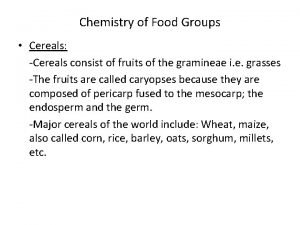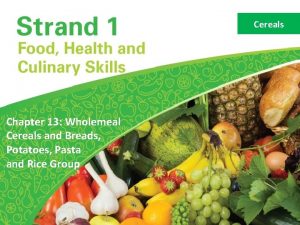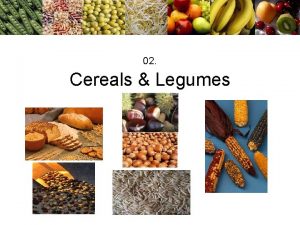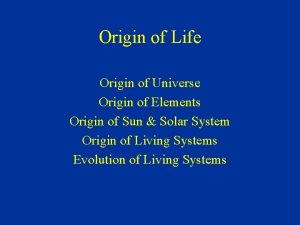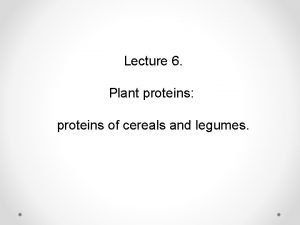CEREALS Origin Cereals are a plant food that










- Slides: 10

CEREALS

Origin Cereals are a plant food, that are edible seeds from grasses.

Classification • There are many classifications of cereal crops, these crops are then turned into products used to make dishes. Example: Crop Product Uses/dishes Wheat Flours, cous, semolina. Bread, cereals, cakes, pastries, pasta etc

Storage KEPT: • To moderate level of humidity (DRY) • Ideally between temperatures of 10 and 20 degree (COOL) • Out of direct sunlight IDEALLY STORED IN SEALED CONTAINER IN PANTRY

Storage • This way cereals and grains may be stored for longer periods of time without the quality being affected. • By: Bacteria Pests such as: weevils, ants or rodents. When buying new stock always use: ‘first in first out system’.

Structure A cereal grain has three layers: Husk (usually removed) Bran Endosperm Germ

Structure/ Chemical Properties • Bran: outer layer, provides main source of fibre (complex carbohydrate) in the cereal grain. • Endosperm: Provides the starch (Carbohydrate) in which white flour is produced. • Germ: the reproductive part of cereal and it contains fats, protein (Gluten), carbohydrate and B group vitamins.

Chemical Properties • Gluten: A protein substance found in many cereal products, including wheat, rye, barley and oats, which gives dough its elastic texture. It is a very elastic tangle of tiny cords which enables it to provide structural functions in baked products. When mixed with water the tiny cords stretch and straighten. Gas produced by yeast is trapped by the gluten structure, rising baked products, giving them firmness and shape.

Functional Properties GELATINISATION: The swelling and consequent thickening of starch granules when they are heated in liquid e. g. Rice –Risotto, Flourcheese sauce. Starch + wet heat = Gelatinisation

Functional Properties • DEXTRINISATION: Browning of starch foods when dry heat is applied e. g Bread –Toast, cake tops. Starch + dry heat = DEXTRINISATION

